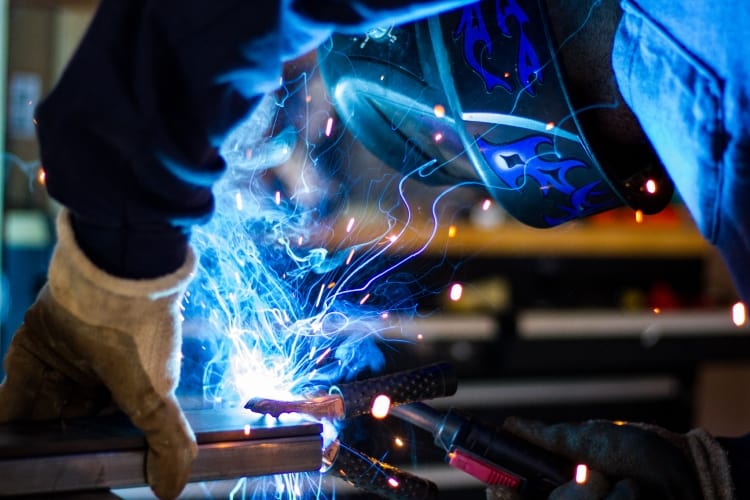In the past few years, using a flux-core welding machine (or gasless MIG, as some like to call them) has become waaay easier. You can actually get some reasonably nice welds with an extremely basic machine.
If you only want to know the quick and dirty basics so you can weld stainless steel with FCAW, here you go:
Buy some 308LFC from Blue Demon and go to town. It’s not overly complicated, and you can probably figure it out with a bit of practice.
That will work on the large majority of 300 series stainless and grade 430. If you don’t know what you’re working with, make sure to check out my guide on how to identify different stainless grades.
If you want some tips and tricks and what to expect, I do think it’s worth the few minutes of your time to read through this post.
Table of Contents
Pros and Cons of Flux Core Arc Welding Stainless
Before getting too far along it’s good to know why you would and why you would not want to FCAW (commonly misnomered “gasless MIG”) stainless steel.
Good reasons for using FCAW on stainless:
- You’re a hobbyist and don’t work with stainless often. It’s not overly expensive to get a smaller roll of flux-cored wire for small jobs, and you don’t need to change around your cylinders. Gas for MIG welding stainless isn’t the same as the gas you use for carbon steel.
- You need to weld stainless outside in windy conditions and are opposed to using an arc welder. You’ll often have less splatter with a FCAW weld.
- You only have a FCAW machine.
Disadvantages of using FCAW for welding stainless:
- It’s really hard to find welding wire that’s suitable for vertical welding, almost all of it is just for flat/horizontal. This means it’s a total pain for jobs like exhaust pipes, where you need to weld in all positions. MIG is better for all positions.
- If your welder is REALLY cheap, you might only have the option of running electrode negative, which is what’s used for carbon steel welding. For stainless, you generally need to weld electrode positive.
- As with any FCAW process, you’ll get slag that protects the weld. It’s not just a matter of cleaning the slag, but there’s also a higher risk of getting slag inclusions in the metal.
- It’s obviously nowhere near as clean, pretty, and strong as a good TIG weld.
How FCAW Stainless Welding is Different from MIG
One of the things that you’ll immediately notice is that the arc is totally different with FCAW.
Every time I’ve done it, it’s been extremely crackly. The arc isn’t smooth and steady like it is with MIG. It kind of sounds like if you were to run MIG without shielding gas, in my opinion.
Actually, trying to watch the melt pool will probably just distract you and get you to mess up. If you try to control the puddle, you’re likely to move too slow and your weld bead will be ugly.
I’d recommend just laying down a few practice beads to get the hang of it before doing your real welds. Lay down a few inches of bead, then stop to see how it’s coming out.
Then you’ll develop a feel for understanding where the wire needs to be instead of where the pool is.
My first reaction to stainless FCAW was “woah, this is all wrong!”… but then after I looked at the bead, I was surprised that it was actually pretty good.
Then I got over the terrible sound it makes and realized it was a pretty cool, simple way of welding stainless.
Dialing In Your Settings
Here are some basic welding settings and how they affect your welds with stainless FCAW:
Always check the recommended polarity of the wire you’re using for stainless FCAW
Low wire speed: You’ll have excessive spatter.
High wire speed: The wire will stub and push as you weld.
***note: wire speed is directly related to amperage. Higher amperage allows for higher wire speeds, lower amperage means lower wire speeds.
Slow weld travel: Your bead will crown high and the slag won’t cover the weld well. It’ll tend to leave the weld exposed near the crown, and the metal will turn gray. You’ll probably have porosity issues and the weld might be prone to rust.
Fast weld travel: The weld will turn out extra ropey and the weld bead will be too narrow.
Tip to work distance too short: The flux won’t be preheated enough and you’ll get poor flux coverage. Similar to slow travel speed, your weld will probably be dark on the top and you’ll likely have porosity issues.
Tip to work distance too long: It’ll be harder to control the weld, and you’ll see ripples in the weld bead.
Wrong polarity: You’ll have a ridiculous amount of large spatter. Some people call it buckshot spatter. If you’re using the wire I recommended above, you’ll need to run DCEP (straight polarity)
Stainless Steel Welding Tips
With slag, you drag. This is a general tip for any kind of FCAW or arc welding. By dragging the electrode, you’re allowing the flux to rise to the top of the weld pool and give you proper coverage. Otherwise, you can have issues with slag inclusions in your weld bead.
For FCAW stainless, a 10 degree drag angle should generally work just fine.
Trim the wire tip every time you lay a bead. If you don’t trim the wire, you will often get a silicon blob at the tip of your wire that can mess up your start.

